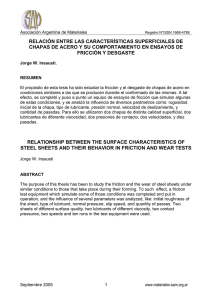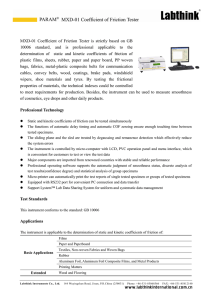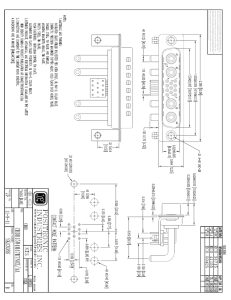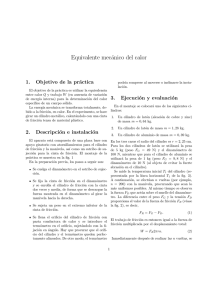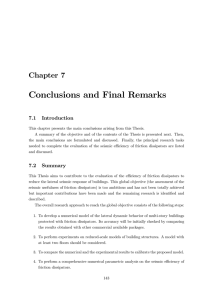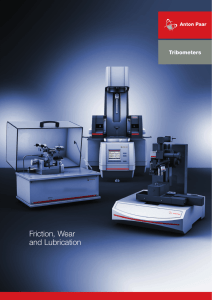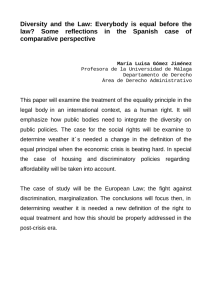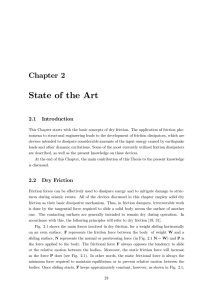The metal-tool contact friction at the ultrasonic vibration drawing of
Anuncio
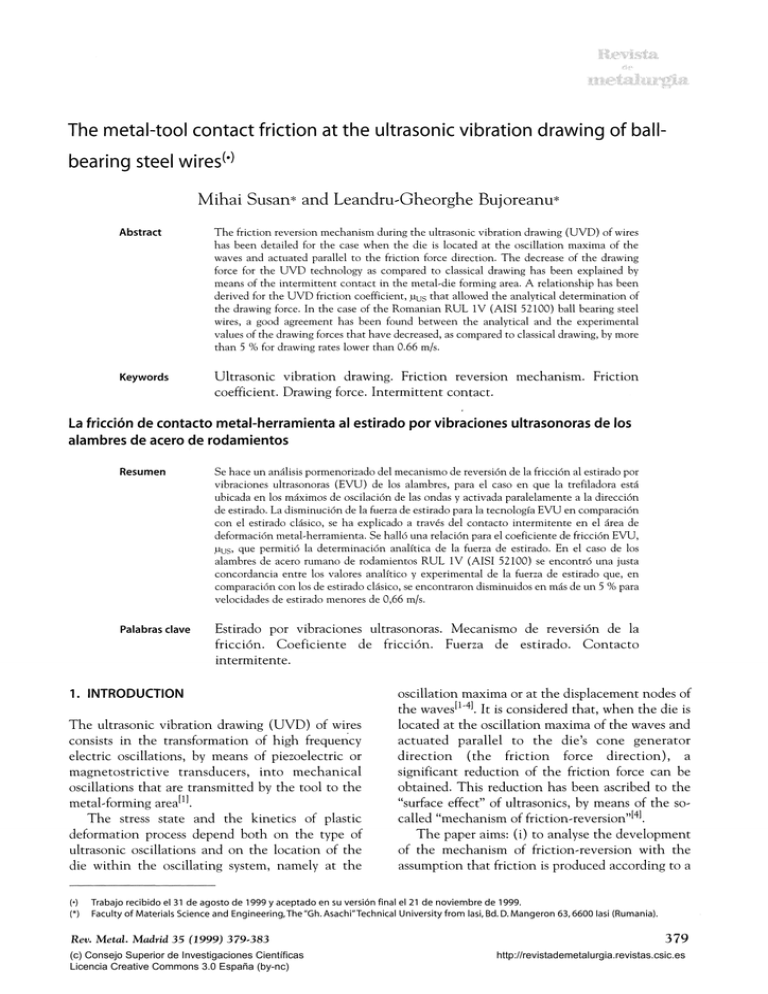
The metal-tool contact friction at the ultrasonic vibration drawing of ballbearing steel wiresw
Mihai Susan* and Leandru-Gheorghe Bujoreanu*
Abstract
The friction reversión mechanism during the ultrasonic vibration drawing (UVD) of wires
has been detailed for the case when the die is located at the oscillation máxima of the
waves and actuated parallel to the friction forcé direction. The decrease of the drawing
forcé for the UVD technology as compared to classical drawing has been explained by
means of the intermittent contact in the metal-die forming área. A relationship has been
derived for the UVD friction coefficient, u u s that allowed the analytical determination of
the drawing forcé. In the case of the Romanian RUL IV (AISI 52100) ball bearing steel
wires, a good agreement has been found between the analytical and the experimental
valúes of the drawing forces that have decreased, as compared to classical drawing, by more
than 5 % for drawing rates lower than 0.66 m/s.
Keywords
Ultrasonic vibration drawing. Friction reversión mechanism. Friction
coefficient. Drawing forcé. Intermittent contact.
La fricción de contacto metal-herramienta al estirado por vibraciones ultrasonoras de los
alambres de acero de rodamientos
Resumen
Se hace un análisis pormenorizado del mecanismo de reversión de la fricción al estirado por
vibraciones ultrasonoras (EVU) de los alambres, para el caso en que la trefiladora está
ubicada en los máximos de oscilación de las ondas y activada paralelamente a la dirección
de estirado. La disminución de la fuerza de estirado para la tecnología EVU en comparación
con el estirado clásico, se ha explicado a través del contacto intermitente en el área de
deformación metal-herramienta. Se halló una relación para el coeficiente de fricción EVU,
Mus» Que permitió la determinación analítica de la fuerza de estirado. En el caso de los
alambres de acero rumano de rodamientos RUL IV (AISI 52100) se encontró una justa
concordancia entre los valores analítico y experimental de la fuerza de estirado que, en
comparación con los de estirado clásico, se encontraron disminuidos en más de un 5 % para
velocidades de estirado menores de 0,66 m/s.
Palabras clave
Estirado por vibraciones ultrasonoras. Mecanismo de reversión de la
fricción. Coeficiente de fricción. Fuerza de estirado. Contacto
intermitente.
1. INTRODUCTION
The ultrasonic vibration drawing (UVD) of wires
consists in the transformation of high frequency
electric oscillations, by means of piezoelectric or
magnetostrictive transducers, into mechanical
oscillations that are transmitted by the tool to the
metahforming area^\
The stress state and the kinetics of plástic
deformation process depend both on the type of
ultrasonic oscillations and on the location of the
die within the oscillating system, namely at the
(*)
(*)
oscillation máxima or at the displacement nodes of
the waves^ . It is considered that, when the die is
located at the oscillation máxima of the waves and
actuated parallel to the die's cone generator
direction (the friction forcé direction), a
significant reduction of the friction forcé can be
obtained. This reduction has been ascribed to the
"surface effect" of ultrasonics, by means of the socalled "mechanism of friction-reversion" .
The paper aims: (i) to analyse the development
of the mechanism of friction-reversion with the
assumption that friction is produced according to a
Trabajo recibido el 31 de agosto de 1999 y aceptado en su versión final el 21 de noviembre de 1999.
Faculty of Materials Science and Engineering,The "Gh. Asachi"Technical University from lasi, Bd. D. Mangeron 63,6600 lasi (Rumania).
Rev. Metal Madrid 35 (1999)
379383
(c) Consejo Superior de Investigaciones Científicas
Licencia Creative Commons 3.0 España (by-nc)
379
http://revistademetalurgia.revistas.csic.es
The metal-tool contact friction at the ultrasonic vibration drawing...
Coulomb-type law and (ii) to evalúate the effects
of applying the UVD technology in the case of
ball-bearing steel wires.
(a) _o
2. EXPERIMENTAL PROCEDURE
The experiments have been performed by single
stage drawing of the wires made from the
Romanian steel RUL IV (AISI-52100). The
chemical composition of raw wires was: 1.2 % C,
0.4 % Mn, 0.3 % Si, 1.5 % Cr, 0.02 % S, 0.02 % P,
0.08 % Mo, 0.2 % Ni and 0.2 % Cu (wt.%). The
wires, with an initial diameter D 0 = 3.8 mm, have
been annealed and subsequently prepared for UVD
Metallic carbide (WC) dies, with convergent
conical geometry ( a = 8 ) have been used. As
lubricant, a mixture of soap powder with 10-15%
fine lime powder and 12-15 % tale powder has been
used.
T h e laboratory installation allows the
measurement of both technological and ultraacoustic specific parameters. It comprises three
main parts: (i) the drawing equipment with electric
actuation and step-variation of speed; (ii) the
ultrasonic generator, type U.Z.G. 2-4M and (iii)
the oscillating system including the magnetostrictive
transducer, type RM.S. 15A-18, with resonance
frequencyf= 17.510 3 Hz.
The oscillating system is illustrated in figure 1. Its
length is calculated, according to the principie of
resonance frequeney, as a múltiple of X/2 as
illustrated in figure l ( a ) . X is the ultrasonics
wavelength, X = c/f, where c is the ultrasonics
propagation speed through the material under study.
The ultra-acoustic energy reflectors enable the
formation, along a precise distance within the wire,
of a stable system of stationary waves. The stability
of the stationary waves system has been monitored
by means of a X-Y recorder. The oscillating system
is fastened on the stand of the drawing equipment
by means of the nodal flange.
The oscillation amplitude (A) can be modified
either by tuning the pre-magnetization current in
the magnetostrictive transducer or by changing the
geometry of the cylindrical step-concentrator.
Thus, an amplitude A = 25-10 m could be
obtained by setting the amplification factor of the
cylindrical step-concentrator, N = (D/d) 2 , at the
valué N = 3.2. The cylindrical step-concentrator is
made from titanium alloy (Ti-6% Al-4% V). This
alloy has a density p = 4.42 Kg/dm , an ultrasonics
propagation speed c = 4,900 m/s and a high
ultrasonic fatigue Ufe.
380
(c) Consejo Superior de Investigaciones Científicas
Licencia Creative Commons 3.0 España (by-nc)
conical concentrator
nodal flange
Figure 1. The oscillating system used within the UVD
technology applied to RUL IV (AISI 52100) ball-bearing
steel wires: (a) waves oscillation along the oscillating system
and the wire; (b) principie scheme of the oscillating system.
Figura 1. El sistema oscilante utilizado en la tecnología EVU
aplicada a los alambres de acero de rodamientos RUL J V
(AISI 52100): (a) oscilación de las ondas a través del
sistema oscilante y del alambre; (b) esquema de principio
del sistema oscilante.
The drawing forcé was determined by means of
the D . T 106.000-type gauge and a N 2314
tensiometric bridge, both for classical drawing
(with nonactive die) and for the UVD technology.
The displacement rate of the drawn wire (V tr )
has been determined by means of a tachometer
while the die's oscillation amplitude has been
measured by means of a special device that has, as
an active element, an "electret"-type block with
capacitive functions^ \ For the drawing rate (V tr )
the following valúes have been used: 0.33; 0.5; 0.66;
0.83 and 1.0 m/s. The feed rate (Va) has been
determined as a function of the initial and final wire
diameters in the metal-forming área (D 0 and Dj,
respectively) as well as of the geometry of the die:
Va = V t r ( R Í / R 2 0 ) c o s a
(1)
3. DEVELOPMENT OFTHE FRICTION REVERSIÓN
MECHANISM
The principie scheme of the UVD technology, with
the die located at the oscillation máxima of the
waves and actuated parallel to the drawing
direction, has been determined by developing the
approach found in™ and is illustrated in figure 2. It
is assumed that, within the deformation área, the
metal is subjected to two motions with different
rates: an oscillation motion, determined by the
Rev. Metal. Madrid 35 (1999)
http://revistademetalurgia.revistas.csic.es
MíHAÍ SüSAN AND LEANDRU-GHEORGHE
BÜ]OREANU
Figure 2. Scheme of the metal-forming área, according to
the UVD technology.
Figura 2. Esquema del área de deformación, conforme a la
tecnología EVU.
ultraacoustically actuated tool and a slip motion,
determined by the drawing process. According to
the above assumption any point M, arbitrarilychosen within the deformation área in figure 2,
takes part in two motions: a feed motion (with the
rate V a ) and a vibratory motion of the tool (with
the rate V v ).
In the case of the classical drawing (without ultraacoustic actuation of the die) the friction forcé vector
(Ff) opposes the direction of the metal displacement
(Va), while in the case of the UVD it opposes the
direction of the resulting rate vector (determined by
the composition of the rates Vv and V a ).
Under these circumstances, the resulting vector
of the relative rate will influence the motion
direction of the point M as a function of both the
direction of the two rates (Vv and Va) and the
magnitude of the projections of these vectors on the
friction direction, B-B^ as illustrated in figure 3(c).
Thus, during the interval T/2 - 2ti of the oscillation
period, its displacement direction will coincide with
that of the metal and during the interval T/2 + 2t\ it
will move in the opposite direction, as the
projection of the Vv vector along the direction B-Bj
will be larger and smaller, respectively, than the Va
vector. Based on the above considerations, it is
evident from figure 3(c) that during the interval
T/2 - lX\ the friction forcé (Ff) becomes positive and
during T/2 + 2t\ it becomes negative. The dashed
Une illustrates the variation of the average friction
forcé according to the model introduced by
Severdenko™, while the solid line represents the
theoretical variation. In the metal-tool contact área,
the normal stress (a n ) or the pressure induced by the
die, gradually-decreases to zero during the interval
T/2 - 2t\y when Vv >Va, until the metal becomes
fully detached from the tool. Under these
circumstances, the deformation process is
interrupted in such a way that the metal just slips
Rev. Metal. Madrid 35 (¡999)
(c) Consejo Superior de Investigaciones Científicas
Licencia Creative Commons 3.0 España (by-nc)
Figure 3. Metal-forming kinetics, according to the UVD
technology: (a) the displacement wave; (b) variation of the
vibratory rate of the tool (Vv) and the displacement rate of
the metal (V a ); (c) variation of the friction forcé (Ff) .
Figura 3. La cinética de deformación del metal conforme a
la tecnología EVU: (a) la onda de desplazamento; (b)
variación de la velocidad de vibración de la herramienta
(Vv) y de la velocidad de desplazamento del metal (Va); (c)
variación de la fuerza de fricción (Ff).
relative to the die, the friction forcé being
considered as positive (Ff) with relatively low
valúes. During T/2 + 2th when Vv<Va, since the
metal-tool contact is resumed the deformation
process is restored and the pressure created by the
die gradually-increases to the máximum valué,
characteristic of the drawing process. Consequently,
the friction forcé is considered negative (Ff) and
reaches a máximum valué as the wire deforms. In
other words, within the UVD technology, plástic
deformation occurs, by impulses, the metal-tool
contact being periodically resumed, as a function of
the resonance frequency of the oscillating system.
Therefore, a reduction of the friction forcé results,
based on the "reversión of the friction forcé vector",
w henV v >V.
381
http://revistademetalurgia.revistas.csic.es
The metal-tool contact friction at the ultrasonic vibration drawing...
4. DETERMINATION OF THE UVD FRICTION
COEFFICIENT
In the case of Coulomb-type friction, the friction
coefficient ix is generally expressed as:
|l =
T
—
With this valué of ti, the effective influence factor
of the ultraacoustical oscillations on the metal-tool
contact friction becomes:
(2)
where T is the shear stress induced by friction and
Gn is the normal stress on the tool surface, Le. the
pressure produced by the tool in any point of the
contact área.
From figure 3 it is noticeable that the influence
of ultrasonics is directly proportional to the time
interval 2tx and inversely proportional to the period
T/2, which agrees well with the results found rrr .
Consequently, the UVD friction coefficient (|IUS) is
correspondingly lower as compared to the friction
coefficient for classical drawing:
(9)
V„
2
V
*
a
c = — are eos -=^
7C
(10)
Vv
Based on equations (4) and (10), the UVD friction
coefficient JLXUS is expressed as:
1
^ u s = M<
with S Vv
2
V.
— are eos
Tí
Vv J
(11)
< 1.
5 EXPERIMENTAL RESULTS AND DISCUSSION
H-US
w
(3)
T
By designating the effective influence factor of
the ultraacoustical oscillations on the metal-too!
contact friction as £, = 4tj/T, equation (3) becomes:
^us = M I
-S)
(4)
w h e r e O > ^ > 1.
Considering the displacement wave shown in
figure 3(a), at the moment t¡ its equation will be:
AsinCO^
(5)
where A is the amplitude of the tool's oscillations
and CO = 27if is the angular speed.
The vibratory rate of the tool is the derivative
of the displacement wave:
V =
du
áu
The determination of the friction coefficient at
RUL IV steel wire drawing, either with nonactive
die (¡a) either with the die ultraacoustically
activated (flus) i s based on Sachs'relationship of
the drawing forcé^ .
Si
S,
(6)
2a rad
V v = coA
(7)
From equations (6) and (7) the vibratory rate
becomes:
V = V, • eos cot,
(8)
When the feed and the vibratory rates are equal, t\
becomes:
382
(c) Consejo Superior de Investigaciones Científicas
Licencia Creative Commons 3.0 España (by-nc)
Siacmln;
°1
The máximum valué of the vibratory rate is
obtained for eos cotí = 1 as:
2
\í
a rad
•ad
(12)
/
where S 0 and S\ are the initial and final crosssections áreas of the wire, respectively; Gcm is the
average experimental valué of the tensile yield
stress (for RUL IV, Gcm = 630 MPa) and a rad is the
semiangle of the die's cone (ocrad = 0.0174cxcjeg)«
From equation^1 ^ the friction coefficient can be
determined as:
JA
= A co eos cotí
1+
- 1 a rad
(13)
S,
°1
The effectiveness of ultrasonics regarding the
metal-tool contact friction, as compared to
classical drawing, can be expressed as the relative
reduction of the friction coefficient^ *:
n = 100 [(|l - | A U S ) / M ]
(14)
Similarly, the relative reduction of the drawing
rate, as an effect of ultrasonics, is1 .
m = 100[(Ft-FtUS)/Ft]
(15)
Rev. Metal. Madrid 35 (1999)
http://revistademetalurgia.revistas.csic.es
MlHAI SUSAN AND LEANDRV-GHEORGHE
BUJOREANUS
Table I. Experimental results obtained at the ultrasonic vibration drawing of the RUL IV (AISI 52100) ball-bearing steel wires,
as compared to classical drawing (Ff and |i)
Tabla /.- Resultados experimentales obtenidos en los estirados con vibraciones ultrasonoras de los alambres de rodamientos
RUL 1V (AISI 52 7 00) en comparación con los del estirado clásico (Ff y ¡x)
Kmematic parameters
Friction
coefficients
Dynamic parameters
1
2
3
4
5
Va
[m/s]
Vv
[m/s]
<<l
N°.
va
Ft
[N]
0.29
0.44
0.59
0.73
0.89
2.74
2.74
2.74
2.74
2.74
0.1
0.16
0.21
0.27
0.32
1410
1410
1410
1410
1410
The experimental results are summarized in
table L The valúes F t and F t u | are experimentally
determined and F t us is analytically determined by
means of equation (12). The relative decreases of
the friction coefficient as an effect of ultrasonics
range between 28 and 33 %. As a matter of fact,
the lower the ratio V a /V v the larger the ultrasonics
effectiveness.
The
difference
obtained
between the
experimental and the analytical valúes of the
drawing forcé, Ft{)s and FtQs , respectively, might be
caused by a much more complex influence of
ultrasonics upon the plástic deformation processes.
For instance, a more uniform distribution of the
deformation on the cross-section of the drawn
product occurs due to the intermittent metal forming
that causes a decrease of the work hardening degree
and an increase of the lubricant's effectiveness
within the oscillation knots of the waves.
c an
Hus
"tus
[N]
^tus
[N]
H
1333
1335
1337
1340
1342
1301
1309
1315
1319
1325
0.0378
0.0378
0.0378
0.0378
0.0378
0.0253
0.0258
0.0263
0.0267
0.0272
Relative
decrease
n
m
[%]
[%]
33.06
31.74
30.42
29.36
28.04
5.46
5.31
5.17
4.96
4.82
proved the effectiveness of the U V D technology
that has caused relative decreases above 30 % and
5 % for the friction coefficients and the drawing
forces, respectively, providing the ratio V a /V v w a s
lower than 0.21. Therefore the U V D technology
improves the plástic deformation process and is
especially recommended for the cold-working by
classical drawing of high strength wires
characterized by intense friction as well as by low
drawing rates and cross-section reductions.
REFERENCES
[1] L ÜANSHI and L XlAOPlNG, , Wire Ind. January (1994)
31-39.
[2] O. DRAGAN and E. SEGAL, Metalurgia 24 (1972) 469-
471.
[3] N. ATANASIU, Metalurgia 28 (1976) 96-100.
[4] V.P. SEVERDENKO, V.V. KLUBOVICI and A.V. STEPANENKO,
Prokatka i volocenie c ulitrazvukom, Nauka i tehnika
(1970)227-229.
6. CONCLUSIONS
[5] M. SUSAN, I. Rusu, V. CATARSCHI, G. BADARAU, and C.
In case of the U V D technology, the friction
reversión mechanism has been explained by means
of the intermittent metal-tool contact in the
metal-forming área. Considering the effect of
ultrasonics, an analytical relationship has been
derived for the friction coefficient. |Ltys- T h e
experiments performed on ball-bearing steel wires
BEJENARIU, 5 European Confrence on Advanced
Materials and Processes, FEMS, vol. I, Maastricht,
Holanda, 1997, pp 21-23.
[ó] A. LEIDER and J. GRÁBNER, Ziehkraftmessung beim
Drahtziehen, Drahtwelt 59 (1973) 394-398.
[7] O. DRAGAN et ai, Ultrasunete de mari energii, Editura
Academiei, Bucuresti, Rumania, 1983 pp. 130-132.
[8] N. MOROPSIS, Wire Ind. June (1991) 327-333.
Rev. Metal. Madrid 35 (1999)
(c) Consejo Superior de Investigaciones Científicas
Licencia Creative Commons 3.0 España (by-nc)
383
http://revistademetalurgia.revistas.csic.es
